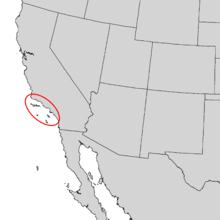Ceanothus arboreus
Ceanothus arboreus, with the common names feltleaf ceanothus, island ceanothus, and island mountain lilac, is a species of Ceanothus shrub in California. [2][3]
| Ceanothus arboreus | |
|---|---|
| Scientific classification | |
| Kingdom: | Plantae |
| Clade: | Tracheophytes |
| Clade: | Angiosperms |
| Clade: | Eudicots |
| Clade: | Rosids |
| Order: | Rosales |
| Family: | Rhamnaceae |
| Genus: | Ceanothus |
| Species: | C. arboreus |
| Binomial name | |
| Ceanothus arboreus | |
 | |
| Natural range of Ceanothus arboreus | |
Distribution
The plant is endemic to coastal southern California, primarily on three of the Channel Islands: Santa Cruz Island, Santa Rosa Island, and Santa Catalina Island.[2][4]
It is found on slopes in coastal sage scrub and chaparral habitats.[2]
Description
Ceanothus arboreus is a spreading bush growing up to 12–36 feet (3.7–11.0 m) in height.[4] It has large, glossy, dark green leaves which are leathery or felt-like on their undersides.[4]
Its showy bright blue flowers grow in plentiful panicles, or bunches, of tiny five-lobed blossoms.[4] Some varieties and cultivars have light, powder blue blooms, and others bear darker blue flowers. The bloom period is February to April.[2]
The fruits are three-lobed, triangular capsules.[4]
.jpg)
Cultivation
'Ceanothus arboreus is cultivated as an ornamental plant for use in drought tolerant and wildlife gardens and natural landscaping projects.[5][6] Butterflies like the flowers and the quail eat the seeds.[5]
Cultivars
Numerous cultivars have been selected for garden use, including:
- Ceanothus arboreus 'Cliff Schmidt' — more compact habit and deeper blue flowers.[7]
- Ceanothus arboreus 'Owlswood Blue'.[8]
- Ceanothus arboreus 'Powder Blue' — Powder Blue Ceanothus, Compact Feltleaf Ceanothus.[9][10][11]
- Ceanothus arboreus 'Skylark'
- Ceanothus arboreus 'Trewithen Blue' — very dark blue flowered form from the Channel Islands.[12] It has received the Royal Horticultural Society's Award of Garden Merit.[13]
See also
- Endemic flora of California
- Natural history of the Channel Islands of California
- Flora of the California chaparral and woodlands
References
- C. arboreus was first described and published in Bulletin of the California Academy of Sciences, 2(6): 144. 1886. "Plant Name Details for Ceanothus arboreus". IPNI. Retrieved August 22, 2010.
- Calflora: Ceanothus arboreus
- GRIN-Global Web v 1.9.6.2: taxonomy of Ceanothus arboreus
- Jepson eFlora: Ceanothus arboreus
- Las Pilitas Nursery Horticultural Database: Ceanothus arboreus (Tree Lilac, Island Mt. Lilac)
- Lady Bird Johnson Wildflower Center Native Plant Information Network−NPIN: Ceanothus arboreus (Feltleaf ceanothus, Island ceanothus, Island mountain lilac)
- Buena Nursery native plants database: Ceanothus arboreus 'Cliff Schmidt'
- Las Pilitas Nursery Horticultural Database: Southern California Lilacs, Ceanothus spp. and cultivars.
- San Marcos Growers Horticulture Database: Ceanothus arboreus 'Powder Blue'
- The Santa Barbara Botanic Garden.org: Ceanothus 'Powder Blue' — with images.
- Yerba Buena Nursery native plants database: Ceanothus arboreus 'Powder Blue'
- Yerba Buena Nursery native plants database: Ceanothus arboreus 'Trewithen Blue'
- "RHS Plant Selector - Ceanothus arboreus 'Trewithen Blue'". Retrieved 15 April 2020.
External links
| Wikimedia Commons has media related to Ceanothus arboreus. |